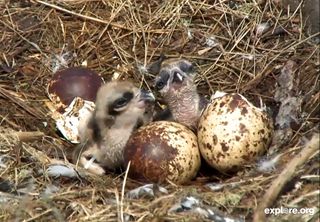Squee! See Newly Hatched Osprey Chicks on Live 'Critter Cam'

For all you bird lovers out there, you can watch a set of newly hatched osprey chicks ruffle their tiny feathers on a live webcam.
Nearly 5 million people have tuned in to the explore.org critter cam, located on Hog Island in Bremen, Maine, to watch some of the first chicks of the season hatch.
A monogamous pair of birds — dubbed Steve and Rachel by viewers — returns to this nest every year to raise their young. Two chicks have hatched already, and a third is expected to emerge any day. [See livestream of the newly-hatched osprey chicks]
The Hog Island ospreys typically spend their winter in South America. The lovebirds returned to Maine in late April and performed their courtship rituals. Steve gathered sticks and soft bark to line the nest, while Rachel prepared the nest for her eggs, according to representatives from explore.org.
When a pair of ospreys bonds, they will attempt to mate more than 160 times over a period of weeks, resulting in a clutch of two to four eggs. The eggs will incubate for between 35 and 42 days before hatching. While a female incubates her eggs, her mate provides most of her meals (osprey eat a diet almost exclusively of fish). The eggs and chicks are almost never left alone, including at night.
About 50 days after they hatch, chicks will start exercising their wings and will practice flying from the nest. In early September, they will launch on a solo journey along the Atlantic Flyway, from Maine to South America, via the Caribbean.
Explore.org is also operating a live puffin cam. The bird that can be seen in the burrow is incubating an egg that is expected to hatch in mid-June.
Sign up for the Live Science daily newsletter now
Get the world’s most fascinating discoveries delivered straight to your inbox.
Puffins were wiped out in Maine by hunters and egg snatchers, but the National Audubon Society's Project Puffin reintroduced the birds in the 1970s.
Editor's Note: If you have an amazing animal photo you'd like to share for a possible story or image gallery, please contact managing editor Jeanna Bryner at LSphotos@livescience.com.
Follow Tanya Lewis on Twitter and Google+. Follow us @livescience, Facebook & Google+. Original article on Live Science.
